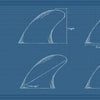Select your surfboard size
How to size your surfboard
Selecting the ideal surfboard size is a crucial decision. Choosing the wrong board could make your experience difficult and discouraging. Also, it could cost a lot of money if you buy a board that doesn't fit the surfer's style, skill, weight, or fitness.
It would be wise to invest some time in understanding surfboard features. This knowledge empowers you to make informed decisions, ensuring that your board perfectly matches your skill level and surfing goals.
While seeking advice at a surf shop is a common step, experiences can vary. You may find a passionate expert eager to guide you meticulously or encounter advises that misses the mark.
Investing in a custom surfboard greatly increases your chances of receiving expert guidance from a skilled and trusted shaper. Still, having a basic understanding of surfboards will enable you to effectively convey your expectations and specific surfing needs to your shaper or to the staff at your local surf shop.
In this blog we'll help you understanding what you need to know to make a great surfboard selection, helping you catch the best waves with the best surfboard!"
Surfboard volume
Volume is the best way to give an idea of the board floatation and overall size.
Surfboard volume is usually measure by computer when the board is designed from a 3D software. Volume is in liters and it would be the amount of water you could put inside your board if it was empty.
Even if I think that volume has transformed into a near-sacred metric, often overshadowing other critical aspects of board selection, I still believe that it is a good number to help everyone who is a recreational surfer to guide their decisions.
Knowing your level
Understanding your level is one of the most crucial parts of selecting your board.
I refer myself to the ‘’Tree of Knowledge’’ from Surf Simply it is a great and complete tool to use, I recommend you have a look at it.
You might be more advanced in some aspects of your surfing than others and it is completely normal. But this will give you a good idea of where you are in your surfing to select the right surfboard for your progression.
Level 1
You are learning surf etiquette, how to manage your board in the white water, and how waves break and swim with more stability on your board.
You are learning to paddle, to surf the white water, and how to pop up.
Level 2
You have full understanding of surf etiquette.
You are learning to pass the break with turtle roll and duck dive technique.
You are learning to catch green waves and catch 0-5 out of 10 of the waves you paddle for.
You can pop up and you’re learning to angle your takeoff and bottom turn efficiently.
Level 3
You can duck dive or turtle roll efficiently on shoulder to head-high waves.
You’re understanding where the peak of the wave and you’re learning to position yourself deep.
You can pop up in a motion and ride the waves left and right more than half of the time.
You are learning to angle your takeoff directly to the high line.
You are learning to pump, do floaters, cut back, and carve on rail.
Level 4
You can duck dive or turtle roll efficiently on head-high to overhead waves.
You understand and predict how the wave is forming and surf to target on steeper part of the wave.
You link your maneuvers and surf vertically from top to bottom with ease.
You are learning to snap, layback, aerial, barrel riding, hang 5, hang 10, etc.
Fitness
Surfing is a physical sport that requires a lot of endurance, force, stability and mobility.
If you're a top athlete, with superior strength and agility, you can opt for a board that is 1-2 liters smaller in volume than the standard recommendation for your weight and height. This size reduction allows for more maneuverability and control, giving you an edge in performance. On the other hand, if your fitness level is below average, you might want to consider a board that is 1-2 liters larger. This increase in volume provides additional buoyancy and stability, making it easier to paddle and catch waves, and more forgiving as you develop your skills. Remember, the right surfboard can significantly enhance your experience in the waves, so choose wisely based on your individual fitness and skill level."
Commitment
The size of your surfboard should align with your commitment to the sport. For those who surf only during vacations, perhaps twice a year, a larger board is advisable for added stability. Conversely, daily surfers can benefit from a smaller board for greater maneuverability. Keep in mind that the standard board size recommendations are based on someone surfing 2-3 times a week.
Waves
Your choice of surfboard is significantly influenced by the type of wave you ride. Strong, steep waves permit the use of smaller boards, enabling you to surf in the wave's pocket with greater agility. Conversely, for flatter and weaker waves, a board with more volume is necessary to compensate for the lack of wave power.
Charts
This chart is the average volume recommendation for your level and weight.
Consider that different types of board perform with more volume than others and that you can always seek advice to make a proper decision. Contact us






